Art of Leonardo da Vinci
Analysis and evaluation of Leonardo's achievement
Painting
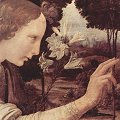 Leonardo's total output in
painting is really not large; only 17 of the paintings that
have survived can be definitely attributed to him, and several of them
are unfinished. Two of his most important works - the "Battle of
Anghiari" and the "Leda," neither of them completed - have only
survived in copies. Yet these few creations have established the
unique fame of a man whom Vasari, in his Lives, dividing art history
into three ages, placed in the last "golden age of the arts." His
works, unaffected by all the vicissitudes of aesthetic doctrines in
subsequent centuries, have stood out in all periods and all countries
as consummate masterpieces of painting.
Leonardo's total output in
painting is really not large; only 17 of the paintings that
have survived can be definitely attributed to him, and several of them
are unfinished. Two of his most important works - the "Battle of
Anghiari" and the "Leda," neither of them completed - have only
survived in copies. Yet these few creations have established the
unique fame of a man whom Vasari, in his Lives, dividing art history
into three ages, placed in the last "golden age of the arts." His
works, unaffected by all the vicissitudes of aesthetic doctrines in
subsequent centuries, have stood out in all periods and all countries
as consummate masterpieces of painting.
The many testimonials to Leonardo, ranging from Vasari to Rubens, Johann Wolfgang von Goethe, and Eugene Delacroix, make it unmistakably clear that it has been, above all, Leonardo's art of expression that has called forth the utmost admiration. It is, in fact, the core of his formation as a painter - from his earliest beginnings to his last work. This expression was nurtured by his power of invention but also by every technical means: drawing, colour, use of light and shadow. To Leonardo, expression became a key concept of art; it also included the basic demands of truth, beauty, and accuracy in everything depicted.
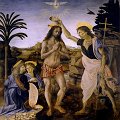 What Leonardo was striving for
was already revealed in his angel in Verrocchio's "Baptism of Christ"
(c. 1474-75): in the natural structuring of the angel's body based on
movement in several directions, in the relaxation of his attitude, and
in his glance, which takes in what is occurring but at the same time
is directed inward. In his landscape segment in the same picture,
Leonardo also found a new expression for "nature experienced," in
reproducing the forms he perceived as if through a veil of mist. The
landscape study (Uffizi, Florence) dated 1473, a pen drawing,
foreshadows in its treatment of transparent atmosphere by a
21-year-old his telling ability to transform perceived phenomena into
convincing graphic forms.
What Leonardo was striving for
was already revealed in his angel in Verrocchio's "Baptism of Christ"
(c. 1474-75): in the natural structuring of the angel's body based on
movement in several directions, in the relaxation of his attitude, and
in his glance, which takes in what is occurring but at the same time
is directed inward. In his landscape segment in the same picture,
Leonardo also found a new expression for "nature experienced," in
reproducing the forms he perceived as if through a veil of mist. The
landscape study (Uffizi, Florence) dated 1473, a pen drawing,
foreshadows in its treatment of transparent atmosphere by a
21-year-old his telling ability to transform perceived phenomena into
convincing graphic forms.
In the "Madonna Benois" (1478) Leonardo succeeded in giving an old traditional type of picture a new, unusually charming, and expressive mood by showing the child Jesus reaching for the flower in Mary's hand in a sweet and tender manner.
His "Portrait of Ginevra de' Benci" (c. 1475-78) opened new paths for portrait painting with his singular linking of nearness and distance.
The emaciated body of his "St. Jerome" (c. 1480) is presented with realistic truth based on his sober and objective studies in anatomy; gesture and look give Jerome an unrivalled expression of transfigured sorrow.
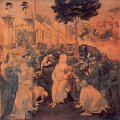 The interplay of mimicry
and gesture - "physical and spiritual motion", in Leonardo's
words - is also the chief concern of his first large creation
containing many figures, "The Adoration of the Magi" (1481). Never
finished, the painting nevertheless affords rich insight into the
master's subtle methods of work. The various aspects of the scene are
"built up" from the base with very delicate, paper-thin layers of
paint in chiaroscuro (the balance of light and shadow) relief. The
main treatment of the Virgin and Child group and the secondary
treatment of the surrounding groups are clearly set apart with a
masterful sense of composition; yet thematically they are closely
interconnected: the bearing and expression of the figures - most
striking in the group of praying shepherds - depict all degrees and
levels of profound amazement. "The Virgin of the Rocks" in its first
version in the Louvre is the work that reveals Leonardo's painting art
at its purest. The painting, according to Leonardo's first contract
with the Confraternity of the Immaculate Conception, was to be the
central panel of a large work for their chapel in the church of S.
Francesco and was done in the years c. 1483-85. It never arrived,
however, at the place it was originally destined for. It seems to have
been prematurely taken from the Confraternity, perhaps by some highly
placed interested party who removed it from Leonardo's workshop.
Instead of this first painting, Leonardo and Ambrogio de Predis
painted a second, slightly revised version, probably begun around
1494. This one gave rise to a 10-year litigation between the artist
and the Confraternity regarding the price, a dispute that was not
settled until 1506 in favour of Leonardo; whereupon, two years later,
the painting was delivered as per contract. This second version
remained in the chapel of S. Francesco until the Confraternity was
dissolved (1781), and then, after changing owners frequently, it came
finally in 1880 to the National Gallery in London.
The interplay of mimicry
and gesture - "physical and spiritual motion", in Leonardo's
words - is also the chief concern of his first large creation
containing many figures, "The Adoration of the Magi" (1481). Never
finished, the painting nevertheless affords rich insight into the
master's subtle methods of work. The various aspects of the scene are
"built up" from the base with very delicate, paper-thin layers of
paint in chiaroscuro (the balance of light and shadow) relief. The
main treatment of the Virgin and Child group and the secondary
treatment of the surrounding groups are clearly set apart with a
masterful sense of composition; yet thematically they are closely
interconnected: the bearing and expression of the figures - most
striking in the group of praying shepherds - depict all degrees and
levels of profound amazement. "The Virgin of the Rocks" in its first
version in the Louvre is the work that reveals Leonardo's painting art
at its purest. The painting, according to Leonardo's first contract
with the Confraternity of the Immaculate Conception, was to be the
central panel of a large work for their chapel in the church of S.
Francesco and was done in the years c. 1483-85. It never arrived,
however, at the place it was originally destined for. It seems to have
been prematurely taken from the Confraternity, perhaps by some highly
placed interested party who removed it from Leonardo's workshop.
Instead of this first painting, Leonardo and Ambrogio de Predis
painted a second, slightly revised version, probably begun around
1494. This one gave rise to a 10-year litigation between the artist
and the Confraternity regarding the price, a dispute that was not
settled until 1506 in favour of Leonardo; whereupon, two years later,
the painting was delivered as per contract. This second version
remained in the chapel of S. Francesco until the Confraternity was
dissolved (1781), and then, after changing owners frequently, it came
finally in 1880 to the National Gallery in London.
"The Virgin of the Rocks" depicts the apocryphal legend of the meeting in the wilderness between the boy John and the equally young Jesus returning home from Egypt. Leonardo's artistry makes of this theme a vision that the true believer experiences when he contemplates the devotional picture. In the visionary character of the picture lies the secret of its effect: it presents not a "reality" but a "manifestation." Leonardo uses every artistic means at his disposal to emphasize the visionary nature of the scene. The soft colour tones (his famous sfumato), the dim light of the cave from which the figures emerge bathed in light, their quiet attitude, the meaningful gesture with which the angel (the only one facing the viewer) points to John as the intercessor between the Son of God and humanity - all this combines, in a patterned and formal way, to achieve an effect of the highest expressiveness.
The Last Supper
 Leonardo's "Last Supper" is
among the most famous paintings in the world. In its monumental
simplicity, the composition of the scene is masterful; the power of
its effect comes from the striking contrast in the attitudes of the 12
disciples as counterposed to Christ. Leonardo did not choose the
portrayal of the traitor Judas customary in the iconographic
tradition; he portrayed, rather, that moment of highest tension as
related in the New Testament, "One of you which eateth with me will
betray me." All of the Apostles - as human beings who do not
understand what is about to occur - are agitated, whereas Christ
alone, conscious of his divine mission, sits in lonely, transfigured
serenity. Only one other being shares the secret knowledge: Judas, who
is both part of and yet excluded from the movement of his companions;
in this isolation he becomes the second lonely figure - the guilty one
- of the company.
Leonardo's "Last Supper" is
among the most famous paintings in the world. In its monumental
simplicity, the composition of the scene is masterful; the power of
its effect comes from the striking contrast in the attitudes of the 12
disciples as counterposed to Christ. Leonardo did not choose the
portrayal of the traitor Judas customary in the iconographic
tradition; he portrayed, rather, that moment of highest tension as
related in the New Testament, "One of you which eateth with me will
betray me." All of the Apostles - as human beings who do not
understand what is about to occur - are agitated, whereas Christ
alone, conscious of his divine mission, sits in lonely, transfigured
serenity. Only one other being shares the secret knowledge: Judas, who
is both part of and yet excluded from the movement of his companions;
in this isolation he becomes the second lonely figure - the guilty one
- of the company.
In the profound conception of his theme, in the perfect yet seemingly simple arrangement of the individuals, in the temperaments of the Apostles highlighted by gesture and mimicry, in the drama and at the same time the sublimity of the treatment, Leonardo attained a height of expression that has remained a model of its kind. Untold painters in succeeding generations, among them great masters such as Rubens and Rembrandt, marvelled at Leonardo's composition and were influenced by it. The painting also inspired some of Goethe's finest pages of descriptive prose. It has become widely known through countless reproductions and prints, the most important being those produced by Raffaello Morghen in 1800. Thus, the "Last Supper" has become part of humanity's common heritage and remains today one of the world's outstanding paintings.
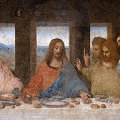 Technical deficiencies
in the execution of the work have not lessened its fame. Leonardo was
uncertain about the technique he should use. He bypassed fresco
painting, which, because it is executed on fresh plaster, demands
quick and uninterrupted painting, in favour of another technique he
had developed: tempera on a base mixed by himself on the stone wall.
This procedure proved unsuccessful, inasmuch as the base soon began to
be loosened from the wall. Damage appeared by the beginning of the
16th century, and deterioration soon set in. By the middle of the
century the work was called a ruin. Later, inadequate attempts at
restoration only aggravated the situation, and not until the most
modern restoration techniques were applied after World War II was the
process of decay halted.
Technical deficiencies
in the execution of the work have not lessened its fame. Leonardo was
uncertain about the technique he should use. He bypassed fresco
painting, which, because it is executed on fresh plaster, demands
quick and uninterrupted painting, in favour of another technique he
had developed: tempera on a base mixed by himself on the stone wall.
This procedure proved unsuccessful, inasmuch as the base soon began to
be loosened from the wall. Damage appeared by the beginning of the
16th century, and deterioration soon set in. By the middle of the
century the work was called a ruin. Later, inadequate attempts at
restoration only aggravated the situation, and not until the most
modern restoration techniques were applied after World War II was the
process of decay halted.
The Mona Lisa and other works
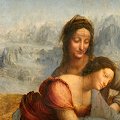 In the
Florence years between 1500 and 1506, four great creations appeared
that confirmed and heightened Leonardo's fame: the "Virgin and Child
with St. Anne" (Louvre), "Mona Lisa," "Battle of Anghiari," and
"Leda." Even before it was completed, the "Virgin and Child with St.
Anne" won the critical acclaim of the Florentines; the monumental
plasticity of the group and the calculated effects of dynamism and
tension in the composition made it a model that inspired Classicists
and Mannerists in equal measure. The "Mona Lisa" became the ideal type
of portrait, in which the features and symbolic overtones of the
person painted achieved a complete synthesis. The young Raphael
sketched the work in progress, and it served as a model for his
"Portrait of Maddalena Doni." Similarly, the "Leda" became a model of
the figura serpentinata ("sinuous figure") - that is, a figure built
up from several intertwining views. It influenced such classical
artists as Raphael, who drew it, but it had an equally strong effect
on Mannerists such as Jacopo Pontormo.
In the
Florence years between 1500 and 1506, four great creations appeared
that confirmed and heightened Leonardo's fame: the "Virgin and Child
with St. Anne" (Louvre), "Mona Lisa," "Battle of Anghiari," and
"Leda." Even before it was completed, the "Virgin and Child with St.
Anne" won the critical acclaim of the Florentines; the monumental
plasticity of the group and the calculated effects of dynamism and
tension in the composition made it a model that inspired Classicists
and Mannerists in equal measure. The "Mona Lisa" became the ideal type
of portrait, in which the features and symbolic overtones of the
person painted achieved a complete synthesis. The young Raphael
sketched the work in progress, and it served as a model for his
"Portrait of Maddalena Doni." Similarly, the "Leda" became a model of
the figura serpentinata ("sinuous figure") - that is, a figure built
up from several intertwining views. It influenced such classical
artists as Raphael, who drew it, but it had an equally strong effect
on Mannerists such as Jacopo Pontormo.
In the "Battle of Anghiari" (1503-06) Leonardo's art of expression reached its high point. The preliminary drawings - many of which have been preserved - reveal Leonardo's lofty conception of the "science of painting"; the laws of equilibrium that he had probed in his studies in mechanics were put to artistic use in this painting. The "centre of gravity" lies in the group of flags fought for by all the horsemen. For a moment the intense and expanding movement of the swirl of riders seems frozen; this passing moment, the transition from one active movement to the next, is uniquely interpreted.
On the other hand, Leonardo's studies in anatomy and physiology influenced his representation of human and animal bodies, particularly when they were in a state of excitement. He studied and described extensively the baring of teeth and puffing of lips as signs of animal and human anger. On the painted canvas, rider and horse, their features distorted, are remarkably similar in expression.
The highly imaginative trappings take the event out of the sphere of the historical into a timeless realm. Thus, the "Battle of Anghiari" became the standard model for a cavalry battle. Its composition has influenced many painters: from Rubens in the 17th century, who made the most impressive copy of the scene from Leonardo's now-lost cartoon, to Delacroix in the 19th century.
Later painting and drawing
After 1507 - in Milan, Rome, and France - Leonardo did very little painting. He did resume work on the Leda theme during his years in Milan and sketched a variation, the "Kneeling Leda." The drawings he prepared - revealing examples of his late style - have a curious, enigmatic sensuality. Perhaps in Rome he began the "St. John the Baptist," which he completed in France. Bursting all the boundaries of usual painting tradition, he presented Christ's forerunner as the herald of a mystic oracle; his was an "art of expression" that seemed to strive consciously to bring out the hidden ambiguity of the theme.
The last manifestation of Leonardo's art of expression was in his "Visions of the End of the World," a series of pictorial sketches that took the end of the world as its theme. Here Leonardo's power of imagination - born of reason and fantasy - attained its highest level. The immaterial forces in the cosmos, invisible in themselves, appear in the material things they set in motion. What Leonardo had observed in the swirling of water and eddying of air, in the shape of a mountain boulder and in the growth of plants now assumed gigantic shape in cloud formations and rainstorms. The framework of the world splits asunder, but even its destruction occurs - as the monstrously "beautiful" forms of the unleashed elements show - in accordance with the self-same laws of order, harmony, and proportion that presided at its creation and that govern the life and death of every created thing in nature. Without any model, these "visions" are the last and most original expressions of Leonardo's art - an art in which his perception based on saper vedere seems to have come to fruition.
Sculpture
That Leonardo worked as a sculptor from his youth on is borne out by his own statements and those of other sources. In the introduction to his Treatise on Painting he gives painting precedence over sculpture in the hierarchy of the arts; yet he emphasizes that he practices both arts equally. A small group of generals' heads in marble and plaster, works of Verrocchio's followers, are sometimes linked with Leonardo because a lovely drawing on the same theme from his hand suggests such a connection. But the inferior quality of this group rules out an attribution to the master. Not a trace has remained of the heads of women and children that, according to Vasari, Leonardo modelled in clay in his youth.
The two great sculptural projects to which Leonardo devoted himself wholeheartedly stood under an unlucky star; neither the huge, bronze equestrian statue for Francesco Sforza, on which he worked until 1494, nor the monument for Marshal Trivulzio, on which he was busy in the years 1506-11, were brought to completion. Leonardo kept a detailed diary about his work on the Sforza horse; it came to light with the rediscovery of the Madrid MS. 8936. Text and drawings both show Leonardo's wide experience in the technique of bronze casting but at the same time reveal the almost utopian nature of the project. He wanted to cast the horse in a single piece, but the gigantic dimensions of the steed presented insurmountable technical problems. Indeed, Leonardo remained uncertain of the problem's solution to the very end.
The drawings for these two monuments reveal the greatness of Leonardo's concept of sculpture. Exact studies of the anatomy, movement, and proportions of a live horse - Leonardo even seems to have thought of writing a treatise on the horse - preceded the sketches for the monuments. Leonardo pondered the merits of two types, the galloping or trotting horse, and in both cases decided in favour of the latter. These sketches, superior in the suppressed tension of horse and rider to the achievements of Donatello's Gattamelata and Verrocchio's Colleoni sculptures, are among the most beautiful and significant examples of Leonardo's art. Unquestionably - as ideas - they exerted a very strong influence on the development of equestrian statues in the 16th century.
A small bronze of a galloping horseman in Budapest is so close to Leonardo's style that, if not from his own hand, it must have been done under his immediate influence (perhaps by Giovanni Francesco Rustici). Rustici, according to Vasari, was Leonardo's zealous student and enjoyed his master's help in sculpting his large group in bronze of "St. John the Baptist Teaching" over the north door of the Baptistery in Florence. There are, indeed, discernible traces of Leonardo's influence in John's stance, with the unusual gesture of his upward pointing hand, and in the figure of the bald-headed Levite. Moreover, an echo of Leonardo's inspiration is unmistakable in the much-discussed and much-reviled wax bust of "Flora" in Berlin. It may have been made in France, perhaps in the circle of Rustici, who entered Francis I's service in 1528.
Architecture
Leonardo, who in a letter to Ludovico Sforza applying for service described himself as an experienced architect, military engineer, and hydraulic engineer, was concerned with architectural matters all his life. But his effectiveness was essentially limited to the role of an adviser. Only once - in the competition for the cupola of the Milan cathedral (1487-90) - did he actually consider personal participation; but he gave up this idea when the model he had submitted was returned to him. In other instances, his claim to being a practicing architect involved sketches for representative secular buildings: for the palace of a Milanese nobleman (around 1490), for the villa of the French governor in Milan (1507-08), and for the Medici residence in Florence (1515). Finally, there was his big project for the palace and garden of Romorantin in France (1517-19). Especially in this last named, Leonardo's pencil sketches clearly reveal his mastery of technical as well as artistic architectural problems; the view in perspective (at Windsor Castle) gives an idea of the magnificence of the site.
Leonardo was also quite active as a military engineer, beginning with the years of his stay in Milan. But no definite examples of his work can be adduced. Not until the discovery of the Madrid notebooks was it known that in 1504, sent probably by the Florence governing council, he stood at the side of the Lord of Piombino when the city's fortifications system was repaired and that Leonardo suggested a detailed plan for overhauling it. Finally, his studies for large-scale canal projects in the Arno region and in Lombardy show that he was also an expert in hydraulic engineering.
But what really characterizes Leonardo's architectural studies and makes them stand out is their comprehensiveness; they range far afield and embrace every type of building problem of his time. Furthermore, there frequently appears evidence of Leonardo's impulse to teach: he wanted to collect his writings on this theme in a theory of architecture. This treatise on architecture - the initial lines of which are in MS. B (Institut de France, Paris), a model book of the types of sacred and profane buildings - was to deal with the entire field of architecture as well as with the theory of forms and construction and was to include such items as urbanism, sacred and profane building, and a compendium of the important individual elements (for example, domes, steps, portals, and windows).
In the fullness and richness of their ideas, Leonardo's architectural studies offer an unusually wide-ranging insight into the architectural achievements of his epoch. Like a seismograph, his observations sensitively register all themes and problems. For almost 20 years he was associated with Bramante at the court of Milan and again met him in Rome in 1513-14; he was closely associated with such other distinguished architects as Francesco di Giorgio, Giuliano da Sangallo, Giovanni Antonio Amadeo, and Luca Fancelli. Thus, he was brought in closest touch with all of the most significant building undertakings of the time. Since Leonardo's architectural drawings extend over his whole life, they span precisely that developmentally crucial period - from the 1480s to the second decade of the 16th century - in which the principles of the classical style were formulated and came to maturity. That this genetic process can be followed in the ideas of one of the greatest men of the period lends Leonardo's studies their distinctive artistic value and their outstanding historical significance.
Science
Notwithstanding Leonardo's abundant scientific activity, one must never lose sight of the fact that it was the intellectual output of a man who proudly and consciously felt himself an artist throughout his life. And he described himself as such. He first came in contact with science as an artist, in the task he set himself of writing a treatise on painting.
Leonardo's famous book on painting, in the form known and read today, is not an original work by the master but a compilation of texts from various manuscripts by Leonardo, collected and arranged with loving care by his disciple and heir, Francesco Melzi. It is the Codex Urbinas Latinus 1270, now in the Vatican Library. It was prepared around 1540-50, but from its form one can see that it was still an unfinished rather than a completed manuscript. Many original texts known to exist are missing; whole sections of Leonardo's overall plan are not included.
The first printed edition of the treatise in Melzi's version, omitting the long introductory chapter concerning the "pecking order" among the arts, appeared in a luxurious binding in 1651 in Paris, published by Raffaelo du Fresne with illustrations after drawings by Nicolas Poussin. The first complete edition of Melzi's text did not appear until 1817, published by Guglielmo Manzi in Rome. The two standard modern editions are that of Emil Ludwig, three volumes, Vienna, 1882 (with German translation); and that of A. Philip McMahon, Princeton, 1956, two volumes (facsimile of the Codex Urbinas and English translation).
Leonardo's plan envisaged a much broader treatment of the theme, as his own allusions to it indicate. For, in addition to detailed practical instructions for painting and drawing, the treatise was to deal with every area involving the artist's perception and experience, which he could then convey as acquired criteria. Three main problems form the keynote of the work: the definition of painting as a science, which is briefly outlined above; the theory of the mathematical basis of painting - that is, geometry, perspective, and optics - with the systematic study of light and shadow, colour, and aerial perspective; and the theory of forms and functions in organic and inorganic nature, as they are explained and made comprehensible to the painter trained in saper vedere. This theory of the forms and functions of the visible world sought first of all to describe the animal world, including man; next it sought to include the plant world; finally it endeavoured to explain how such phenomena of inorganic nature as water and earth, air and fire came into being.
In the drawings for the Treatise on Painting, extending from the earliest Milan period to the final years of Leonardo's life in France, the progressive broadening and deepening of the theme can be followed. Many drawings were placed by the side of the text, and some of them were coloured; many studies of nature that are admired as art works, such as the famous rain landscape (Windsor Castle; 12409) or the "Foliage" (Royal Library, Windsor Castle; 12431), can be identified as illustrations for the treatise. Manuscript C in the Institut de France, Paris, with its diagrams of the blending of lights and shadows, likewise represents a segment of this textbook. Leonardo's so-called grotesque heads are also closely linked with the treatise. They have often been erroneously described as caricatures; but actually, for the most part, they represent types and only occasionally individuals. They are variations of the human face in its gradations between the poles of the beautiful and ugly, the normal and abnormal, the dignified and vulgar. They are also related to anatomical-physiological studies, in which old age - with wrinkled skin and bulging tendons - is contrasted with youth. Representation of the human being was to be treated at length: his body, his proportions, his organs and their functions but also his attitudes in physical and spiritual movement. Here Leonardo's artistic and scientific aims intertwine.
Anatomical studies and drawing
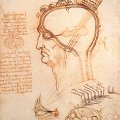 Leonardo's
anatomical studies are perhaps the best way of revealing the process
by which, in Leonardo's mind, an increasing differentiation set in
among his diverse spheres of interest; but it was a differentiation in
which the seemingly divergent areas of study - likewise on a higher
level - always remained interrelated. Thus, Leonardo's study of
anatomy, originally pursued for his training as an artist, quickly
grew into an independent area of research. As his sharp eye uncovered
the structure of the human body, Leonardo became fascinated by the
figura istrumentale dell' omo ("man's instrumental figure"), and he
sought to probe it and present it as a creation of nature. The early
studies dealt chiefly with the skeleton and muscles; yet even at the
outset Leonardo combined anatomical with physiological researches.
From observing the static structure, Leonardo proceeded to study the
functions exercised by the individual parts of the body as they bring
into play the organism's mechanical activity. This led him finally to
the study of the internal organs; among them he probed most deeply
into the brain, heart, and lungs as the "motors" of the senses and of
life. He did practical work in anatomy on the dissection table in
Milan, then in the hospital of Sta. Maria Nuova in Florence, and again
in Milan and Pavia, where he received counsel and inspiration from the
physician-anatomist Marcantonio della Torre. By his own admission he
dissected 30 corpses in his lifetime, thus acquiring an astonishing
range of experience on his own. This experience was distilled in the
famous anatomical drawings, which are among the most significant
achievements of Renaissance science. These drawings, among his
dimostrazione, are based on a curious connection between natural and
abstract representation; sections in perspective, reproduction of
muscles as "strings" or the indication of hidden parts by dotted
lines, and finally a specifically devised hatching system enable him
to represent any part of the body in transparent layers that afford an
"insight" into the organ. Here Leonardo's mastery of drawing proved
most useful. The genuine value of these dimostrazione and their
superiority to descriptive words - as Leonardo proudly emphasized -
lay in the fact that they were able to synthesize a multiplicity of
individual experiences at the dissecting table and make the data
immediately and accurately visible. The effect is unlike that of all
dead anatomical preparations; in this way the "live quality" of the
organism is retained.
Leonardo's
anatomical studies are perhaps the best way of revealing the process
by which, in Leonardo's mind, an increasing differentiation set in
among his diverse spheres of interest; but it was a differentiation in
which the seemingly divergent areas of study - likewise on a higher
level - always remained interrelated. Thus, Leonardo's study of
anatomy, originally pursued for his training as an artist, quickly
grew into an independent area of research. As his sharp eye uncovered
the structure of the human body, Leonardo became fascinated by the
figura istrumentale dell' omo ("man's instrumental figure"), and he
sought to probe it and present it as a creation of nature. The early
studies dealt chiefly with the skeleton and muscles; yet even at the
outset Leonardo combined anatomical with physiological researches.
From observing the static structure, Leonardo proceeded to study the
functions exercised by the individual parts of the body as they bring
into play the organism's mechanical activity. This led him finally to
the study of the internal organs; among them he probed most deeply
into the brain, heart, and lungs as the "motors" of the senses and of
life. He did practical work in anatomy on the dissection table in
Milan, then in the hospital of Sta. Maria Nuova in Florence, and again
in Milan and Pavia, where he received counsel and inspiration from the
physician-anatomist Marcantonio della Torre. By his own admission he
dissected 30 corpses in his lifetime, thus acquiring an astonishing
range of experience on his own. This experience was distilled in the
famous anatomical drawings, which are among the most significant
achievements of Renaissance science. These drawings, among his
dimostrazione, are based on a curious connection between natural and
abstract representation; sections in perspective, reproduction of
muscles as "strings" or the indication of hidden parts by dotted
lines, and finally a specifically devised hatching system enable him
to represent any part of the body in transparent layers that afford an
"insight" into the organ. Here Leonardo's mastery of drawing proved
most useful. The genuine value of these dimostrazione and their
superiority to descriptive words - as Leonardo proudly emphasized -
lay in the fact that they were able to synthesize a multiplicity of
individual experiences at the dissecting table and make the data
immediately and accurately visible. The effect is unlike that of all
dead anatomical preparations; in this way the "live quality" of the
organism is retained.
This great picture chart of the human body was what Leonardo envisaged as a cosmografia del minor mondo ("cosmography of the microcosm"). From the advanced portions that have survived, it is apparent how much and how long it occupied his mind. And it provided the basic principles for modern scientific illustration. Leonardo has not sufficiently received his due in this domain. Thanks to a method of seeing that was peculiarly his own, he elevated the art of drawing into a means of scientific investigation and teaching of the highest quality.
Mechanics and cosmology
With Leonardo, mechanics also proceeds from artistic practice, with which he became quite familiar as an architect and engineer. Throughout his life Leonardo was an inventive builder; he was thoroughly at home in the principles of mechanics of his epoch and contributed in many ways to advancing them.
His model book on the elementary theory of mechanics, which appeared in Milan at the end of the 1490s, was discovered in the Madrid Codex 8937. Its importance lay less in its description of specific machines or work tools than in its use of demonstration models to explain the basic mechanical principles and functions employed in building machinery. Leonardo was especially concerned with problems of friction and resistance. These elements - screw threads, gears, hydraulic jacks, swivelling devices, transmission gears, and the like - are described individually or in various combinations; and here, too, drawing takes precedence over the written word. As in his anatomical drawings, Leonardo develops definite principles of graphic representation - stylization, patterns, and diagrams - that guarantee a precise demonstration of the object in question.
In the course of years his interest in pure mechanics merged increasingly with an interest in applied mechanics. Leonardo realized that the mechanical forces at work in the basic laws of mechanics operate everywhere in the organic and inorganic world. They determine animate and inanimate nature alike as well as man. Leonardo wrote on a page of his treatise on anatomy:
-
See to it that the book of the principles of mechanics precedes
the book of force and movement of man and the other living creatures,
for only in that way will you be able to prove your
statements.
So, finally, "force" became the key concept for Leonardo; as virtu spirituale ("spiritual property"), it shaped and ruled the cosmos.
Wherever Leonardo probed the phenomena of nature, he recognized the existence of primal mechanical forces that govern the shape and function of the universe: in his studies on the flight of birds, in which his youthful idea of the feasibility of a flying apparatus took shape and led to exhaustive research into the element of air; in his studies of water, the vetturale della natura ("conveyor of nature"), in which he was as much concerned with the physical properties of water as with its laws of motion and currents; in his researches on the laws of growth of plants and trees as well as the geological structure of earth and hill formations; and finally in his observation of air currents, which evoked the image of the flame of a candle or the picture of a wisp of cloud and smoke. In his drawings, especially in his studies of whirlpools, based on numerous experiments he undertook, Leonardo again found a stylized form of representation that was uniquely his own: this involved breaking down a phenomenon into its component parts - the traces of water or eddies of the whirlpool - yet at the same time preserving the total picture, analytic and synthetic vision.
Thus, for all the separate individual realms of his knowledge, Leonardo's science offered a unified picture of the world: a cosmogony based on saper vedere. Its final wisdom is that all the workings of nature are subject to a law of necessity and a law of order that the Primo Motore, the divine "Prime Mover," created. "Marvelous is Thy justice, O Prime Mover! Thou hast seen to it that no power lacks the order and value of your necessary governance."
Leonardo as artist-scientist
As the 15th century expired, Scholastic doctrines were in decline, and humanistic scholarship was on the rise. Leonardo, however, was part of an intellectual circle that developed a third, specifically modern form of cognition. In his view the artist - as transmitter of the true and accurate data of experience acquired by visual observation - played a significant part. With this sense of the artist's high calling, Leonardo approached the vast realm of nature to probe its secrets. His utopian idea of transmitting in encyclopaedic form the knowledge thus won was still bound up with medieval Scholastic conceptions, but the results of his research were among the first great achievements of the thinking of the new age because they were based on the principle of experience in an absolutely new way and to an unprecedented degree.
Finally, Leonardo, although he made strenuous efforts to teach himself and become erudite in languages, natural science, mathematics, philosophy, and history, as a mere listing of the wide-ranging contents of his library demonstrates, remained an empiricist of visual observation. But precisely here - thanks to his genius - he developed his own "theory of knowledge," unique in its kind, in which art and science form a synthesis. In the face of the overall achievements of Leonardo's creative genius, the question of how much he finished or did not finish becomes pointless. The crux of the matter is his intellectual force - self-contained and inherent in every one of his creations. This force has remained constantly operative to the present day.
Leonardo da Vinci Art
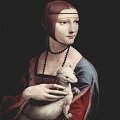
|
|
More
Articles
 Art Encyclopedia A world history of art in articles.
Art Encyclopedia A world history of art in articles.
Renaissance
Leonardo da Vinci
Life and biography.
Evaluation of art.
Art
 Art Wallpapers Art image collections for your desktop.
Art Wallpapers Art image collections for your desktop.
Della Francesca Art, $19
(95 pictures)
Da Vinci Art, $25
(80 pictures)
Michelangelo Art, $29
(180 pictures)
Raphael Art, $25
(125 pictures)
Titian Art, $29
(175 pictures)
Durer Art, $25
(120 pictures)

